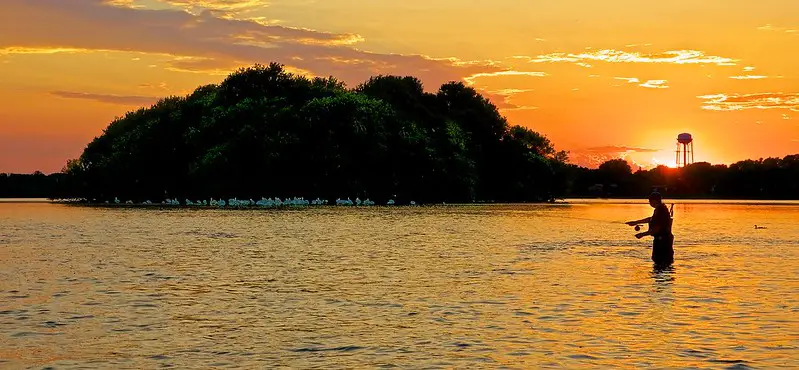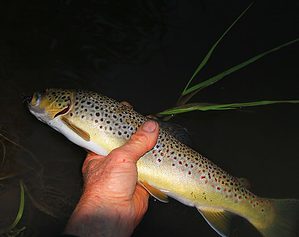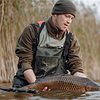Disclosure: Some posts contain affiliate links, which earn us a commission if you make a purchase through them. Positive Fishing © participates in various affiliate networks including the Amazon Services LLC Associates Program.
Creating an equal playing field between the angler and trout isn’t easy. One always seems advantageous depending on conditions, equipment used, and accessibility.
I absolutely love fishing at night for large trout. I can use large flies, rely on my other senses besides vision, and never know what will happen next. Once you fly fish for trout at night, you find that anything is possible and must constantly be ready.
Some of the largest fish will feed in the pitch dark after sunset. If you’re willing to put aside some fears of the dark, you have a chance at an adrenaline rush that’s hard to find in any other fly fishing experience.
The best thing about night fly fishing is the possibility of landing a trophy trout.
In this article, I will cover the following:
- Trout Fishing Gear at Night
- What are the Best Tactics To Use For Trout At Night?
- Mending And Retrieval Techniques At Night
- Final Thoughts
Trout Fishing Gear At Night

well-prepared before the sun sets
Setting up for fly fishing at night doesn’t have to look much different than your setup for daytime fly fishing. There are a couple of things, however, that you should consider bringing along when you hit the water in the dark.
Use A Heavier Rod
If you’re fishing in a river or a lake, it’s not a bad idea to use a bit heavier rod than you normally would. For example, if you’re usually fishing with a 4-weight, it’s not a bad idea to move up to a 5 or 6-weight.
Using a heavier rod is helpful for two main reasons.
First, you have the potential to land a larger fish than you would find during the day.
Secondly, you will be using heavier flies at night. You don’t need to focus on throwing size 18 nymphs with a 6x tippet at night. Your goal is to throw larger-sized flies for bigger fish. As a result, a heavier rod will make the casting process easier! Jump up a weight or two when you go at night.
Use A Reel To Match The Rod
For your reel, your best bet is to match the rod weight you’re using. If you’re using a 6-weight rod, use a 6-weight reel. This is going to ensure a proper balance!
Balance is more important at night. Your senses will be a bit off, so the more you can do to make your life more comfortable, the better.
Also, ensure the reel has a large arbor and a solid disc drag system. You may be surprised at the power and speed trout hit at night. Settling your drag accordingly becomes more important, and be prepared to fight the fish hard! You don’t want them to go 50 yards downstream where you can’t really see what’s happening.
Line
Some anglers choose to use glow-in-the-dark fly lines when they’re fishing at night! It exists, and it actually does make your life a bit easier.
However, if you find yourself a purist, a sink tip or floating line is best, depending on where you’re fishing. Floating line isn’t going to lead to as many snags, which can make a difference when you’re fishing at night!
Match the weight of your line to your fly rod and reel. It makes life easier! However, if you’re like me, I prefer a quality fly line that’s one weight heavier. The line that’s a bit heavier is easier to cast, giving that feeling of more power! This is a preference I’ve found over numerous years of fishing.
Leader
You don’t need to mess around with a 4×9’ tapered leader at night. Short and strong are the two main categories you need to worry about. Use 1x or 2x leader, around 4 to 6 feet long. It’s easier to control and plenty strong. Fish can’t see the leader as easily at night, so don’t fret about a hidden setup.
Flies
For your flies, make sure you have representations of meat. Mice flies, minnows, sculpins, and crayfish patterns should all be in your rotation!
The best streamers to use at night are woolly buggers, marabou, and clouser minnows. Use dark colors on top and light on the bottom to create a distinct outline in poor light conditions. Most streamers you use in the daytime will work at night; however, for added advantage, choose larger sizes than you would fish during the day.
The mini mouse and one of my favorites, the Morrish mouse from Umpqua, are good options for mouse patterns due to their movement and the wide hook gape.
Make sure you pick sizes between 0 and 4. Yes, they’re big, but if you go out at night, don’t you want to catch a giant?
Night Fly Fishing Clothing & Accessories

a great deal in mastering night fishing
You want to ensure you wear your waders and the important safety wading belt! These will give you the most versatility in terms of pursuing fish. Check the weather before you go, and dress appropriately for the rest of your attire!
In terms of accessories, bring a quality headlamp! Ensure the headlamp is fully charged, or you have extra batteries. The headlamp should be at least 300 to 400 lumens for the best illumination.
Also, some anglers will wear safety glasses to prevent a hook from flying at their face and lodging in their eye. If you set a hook and miss or have to pull out a snag, glasses will protect you!
What Are The Best Tactics To Fly Fish At Night?
Let’s go through all the best tactics and techniques for improving your chances on catching trout at night.
So Do Trout Bite At Night?
Yes, trout are hungry at any time of the day. If anything, night fly fishing requires less finesse than for trout during the day. Fish feed differently at night than they do during the day. They’re a bit bolder at night under cover of darkness. Remember, it’s more of a power game at night! All your gear should step up one size for the best chances of catching a large trout during the night.
Types of Water to Fish At Night
There is no better water to fish at night than during the day. However, the lower visibility makes it easier to go fishing with fewer trees in the water or obstacles around to hinder you.
Fish At A Familiar Location
First, I would not recommend going to an unfamiliar body of water to fly fish at night. Go somewhere where you’re familiar with the flow rates, depth, and access. Water at night isn’t something to mess around with, so be familiar with the area before you visit.
Choose Slow Water At Night
You don’t need to fish in extremely fast or deep water at night. Fish slower water. These slow portions of water can be shallow areas, pools, or cut banks.
A portion of water that goes from deep to shallow is where you should spend most of your time. Fish will still feed from below at night, so you can fish a bit higher in the water column if you want!
Big trout are more than willing to feed in slow and shallow water. Casting your big streamer in a shallow area is a great option. You’ll be shocked at how quickly a big fish will pounce. They’re hungry and willing to go after food in all areas of the water.
Find The Banks
Fish will sit along the banks at night because that’s where quite a bit of food can be found. Large fish don’t have to work too hard to find food at night, whether a crayfish sitting shallow or a mouse that accidentally fell in. If you cast along the bank, you’ll find fish.
Casting At Night
When you’re ready to cast, your headlamp comes in handy. Obviously, you don’t want to throw in blind and hope something happens. Take your time to pick your spot and make each cast count!
Pick a tree trunk or a landmark on the other bank; this will help ensure you are always casting in the right place. If there is some moonlight, then night fishing becomes easier to establish landmarks or areas in the water to cast.
Make Short Casts
You don’t have to make a 40-foot cast across the entire river while fishing at night. First, you don’t know what’s all behind you, and you don’t have to go that far for fish. Focus on specific structures, seams, or transitions. Rock piles, pool transitions, and eddies will give you chances at fish. The less line you have out, the less that will go wrong for you!
Fish What You See
With your headlamp, go ahead and survey the water. Fish will still feed on the surface at night, so cast at them if you hear splashes or see rises. Those show there’s a feeding fish in the area.
Cast your large mouse fly or clouser minnow in that direction; you will likely get hooked up with a large trout.
Casting technique is an art form that requires skills and plenty of practice to get perfect, but it’s probably the one critical area fly anglers must master, especially if you plan to venture out at night.
Mending & Retrieval Techniques At Night
The work isn’t done once you throw your fly in the water! Large fish want to be sure that what they’re eating is safe. As a result, you have to make your fly look extra enticing at night.
Slow Retrieve is Best At Night
If you’re fishing slower water, a slow retrieve with your streamer or mouse pattern is an excellent choice. That doesn’t mean stripping 2 inches at a time in a continuous pattern. Make your fly look as if it’s in distress. Complete three strips in a row, then let it sit before recasting again. Fish will hit as soon as they see your fly stop moving.
Use Noisy Flies When Night Fly Fishing
Night fishing is one of the few times you’re encouraged to make noise in fly fishing. Go ahead and let your fly slap the water. It’s going to draw attention! The noise doesn’t have to stop when it hits the water! You can tie a rattle or blades to your fly to add commotion.
Swing Your Flies At Night
If you fish with streamers, you’re familiar with swinging flies! You can still do this at night. Cast up and across the river, let your fly drift down, and wait for it to start swinging across towards you. As it’s swinging, be prepared for it to hit. You can strip hard towards yourself back upstream as soon as it’s almost directly below you.
Final Thoughts
Fly fishing at night can be great fun, resulting in some big trout taking your fly. Always go heavier than your daytime fishing setup.
I hope you enjoyed this article and that the tips help you gain the advantage of catching those bigger trout at night.
If you are new to trout fishing and would like to learn more, check out my beginner’s trout fishing guide, which outlines where to catch trout in lakes, rivers, and streams, including the best bait options.
- Wading Belt Essentials: Ensuring Safer Fishing - January 9, 2024
- Fishing For Catfish (Top Tips, Bait, & Gear To Catch The Big 3) - October 20, 2022
- Fishing Line Strength Vs. Diameter Chart: Why Is It Important? - October 12, 2022

